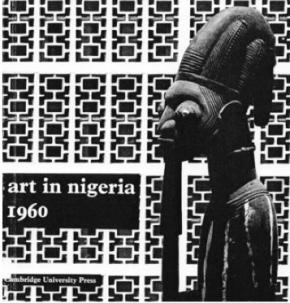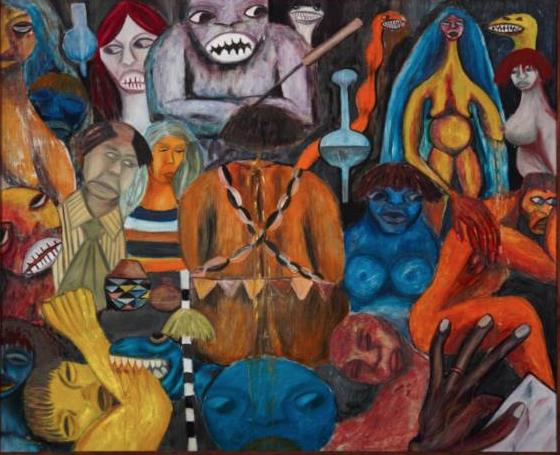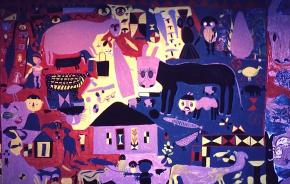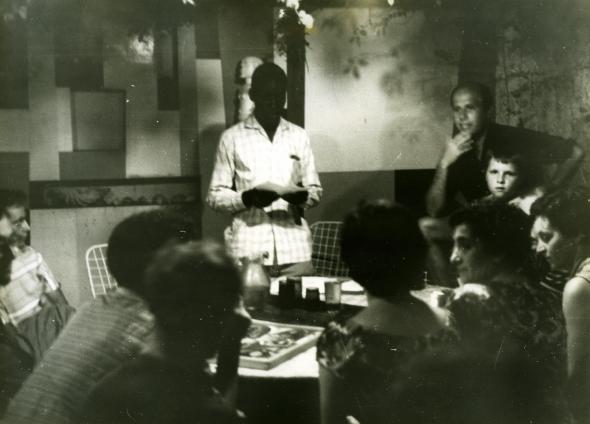In search of new African art in the 1960s. Sponsorship and training in the decade of euphoria - Ulli Beier, Pancho Guedes and Julian Beinart
On the informal network of mediators, patrons and benefactors, which during the 1960s played a crucial role in training and launching artists1, the most influential figure was the German, Ulli Beier (b. 1922 – active in Nigeria until 1967, and then in Papua New Guinea), who was also intensely involved in the fields of African literature and oral poetry.
 Book cover of Ulli Beier, on the occasion of the independence of Nigeria.In “Art in Nigeria 1960” (Cambridge University Press, 1960), in the year of independence, Beier responded to the allegations that prevailed among appreciators of “traditional African art”, “that Africa produced interesting art, as long as the tribal organisation was intact… Modern African artists are European trained and bad, because they are merely copying Europe instead of ‘going back to their own traditions’ ”. Using local examples, Beier shows “that the situation is a great deal more complicated than that; that in Africa, new forms have been evolved independently of European teaching and influence; that traditional art is not as dead as most people think; that the intellectual African artist cannot simply be asked to ‘go back’ to his traditions…” (p. 4, “Introduction”). Included in this issue is the work of European artists and architects in Nigeria, with the argument that one cannot describe the Paris School without mentioning non-French artists. All of the topics discussed over the decade, including production for tourists (“airport art”, according to F. McEwen) occur in this context, in a more operational than theoretical mode, and with subsequent efficiency.
Book cover of Ulli Beier, on the occasion of the independence of Nigeria.In “Art in Nigeria 1960” (Cambridge University Press, 1960), in the year of independence, Beier responded to the allegations that prevailed among appreciators of “traditional African art”, “that Africa produced interesting art, as long as the tribal organisation was intact… Modern African artists are European trained and bad, because they are merely copying Europe instead of ‘going back to their own traditions’ ”. Using local examples, Beier shows “that the situation is a great deal more complicated than that; that in Africa, new forms have been evolved independently of European teaching and influence; that traditional art is not as dead as most people think; that the intellectual African artist cannot simply be asked to ‘go back’ to his traditions…” (p. 4, “Introduction”). Included in this issue is the work of European artists and architects in Nigeria, with the argument that one cannot describe the Paris School without mentioning non-French artists. All of the topics discussed over the decade, including production for tourists (“airport art”, according to F. McEwen) occur in this context, in a more operational than theoretical mode, and with subsequent efficiency.
 Malangatana, Cena de feitiço com casal Guedes, 1961. 100,5 x 122 cm.
Malangatana, Cena de feitiço com casal Guedes, 1961. 100,5 x 122 cm.
After having written about Malangatana in 1962, with the help of Dori and Pancho Guedes and an autobiographical account of himself (Black Orpheus, nº 10), Julian Beinart published the essay “Visual Education for Emerging Cultures: The African Opportunity”, in the book “The Education of Vision”, which was the first of six from the series “Vision + Value” (New York, ed. George Braziller, 1965). This was an influential anthology organised by the Hungarian emigrant Gyorgy Kepes, professor of the New Bauhaus of Chicago, who, at the time, was setting up the Center for Advanced Visual Studies at the Massachusetts Institute of Technology (MIT). This text was particularly geared towards the western context of reflection upon art education, art and design.
In contrast to the context of francophone Africa, where the main interest was in literary works and an idea of blackness that involved the relatively contentious appropriation of European modernity, certain mediators, located further south, questioned the possible evolution of local cultures and of their own major artistic traditions, free from the subordination of European models, which were viewed in a critical way in terms of the visual arts. Within the framework of the inevitable death of the tribal art which was characteristic of traditional societies (even via tourist reproductions), new and spontaneous forms of artistic production (and also sophisticated forms of syncretism in the case of “natural synthesis” proposed by Uche Okeke in the Zaria School) were being sought without any nativist essentialism (in the cases of Beier, Guedes and Beinart).
“Among those replacing the religious artist of the tribe, there are young people who are trying to face a new artistic existence without renouncing their past as worthless. For these, the new post-tribal frame of reference, an international patronage, and the new range of techniques and ideas are accepted as part of the challenge to artists everywhere today; but, unlike many others, they benefit from a heritage which is still very close”, wrote Beinart (p. 192). Ibrahim el Salahi, a Sudanese artist who graduated in Europe, and the above mentioned Uche Okeke, in Nigeria, work within a modern context for an international audience and are inspired by their own cultures. Apart from Sidney Kumalo, the South African sculptor who had no formal education and who participated in the Lourenço Marques “summer school”, the best example is, again, Malangatana: “He is one of a new generation of artists who are beginning a tradition which bridges gaps between old and new, country and city, culture and culture” (p. 193). “Malangatana’s paintings are interpretations of a way of life in which mysticism and fantasy play a large functional role. Although there is a temptation to call his paintings Surrealists, his vision in for him straightforward and real, unlike the intellectual game that it is for many sophisticated European Surrealist painters” (p. 193).
This text deals with the identification of “the first physical results of a transition”, to ponder the future of visual art teaching in Africa, “The first aim of teaching in the visual arts in Africa should be the continuation and expansion of a strong folk tradition” - “Teaching would, in this way, act as research into discovering which traditions of a people remain when their environment changes” (p. 194). This approach incorporates a critical view of how European art was made academic in the 1950s (between the crisis of realisms and the systematisation of informal, expressionist, lyrical and geometrical abstractions), which accompanied the plural break away of the Cobra movement, interest in Art Brut and the search for “other figurations”, which were found with Pop Art (another popular and “low culture” option). In reality, this was all about discovering viable and innovative practices in Africa, in order for it to appear in the international context in its own right, like in the case of the personal work of a Georgina Beier or Pancho Guedes. The intuitive judgement, “the intuitive vision” which William Fagg spoke of, would be “virtually absent from modern art” - There is still time for Africans to save it” (quoted by Beinart, p. 200).
For Beinart, this was about finding the creative force found in the origins of traditional art; those recognised as an innate ability that was adapted to new circumstances and which appeared as a new folk art (different to tribal art), produced by anonymous artists for an urban proletariat, who find avenues for their creativity in new social needs and new environments (p. 187). “Any education in the visual arts in Africa needs to come to terms with the apparent dichotomy between the uses of traditional and new outside sources” (p. 194).
 Detail of mural decoration in the Hotel Chuabo Quelimane (project by Armenio Losa monitored and adjusted by the architect Figueirinhas in 1962). Collective intervention. Pancho Guedes archives.The search for folk art (from cement sculptures to advertising hoardings), and mural paintings in particular, is a common interest among Beier, Guedes and Beinart. The attention given to the murals that were the result of the distribution of paints to cheer up the cane shacks (o Caniço) in Lourenço Marques when the Portuguese president visited in 1956, or the decoration of the Hotel Chuabo in Quelimane (a project of Arménio Losa’s, assisted and adapted by Arch. Figueirinhas, in 19622, are part of the same sequence.
Detail of mural decoration in the Hotel Chuabo Quelimane (project by Armenio Losa monitored and adjusted by the architect Figueirinhas in 1962). Collective intervention. Pancho Guedes archives.The search for folk art (from cement sculptures to advertising hoardings), and mural paintings in particular, is a common interest among Beier, Guedes and Beinart. The attention given to the murals that were the result of the distribution of paints to cheer up the cane shacks (o Caniço) in Lourenço Marques when the Portuguese president visited in 1956, or the decoration of the Hotel Chuabo in Quelimane (a project of Arménio Losa’s, assisted and adapted by Arch. Figueirinhas, in 19622, are part of the same sequence.
Beinart said: “Another way of building bridges to allow the strength of a folk tradition to cross and adapt to new ideas and techniques can be seen in the work done by Amancio Guedes, a Portuguese architect and painter, with relatively untrained people in Mozambique. Guedes, who has been attracted by the spontaneous ability of these people, runs an architectural practice using only people whom he has trained himself. In his backyard works a woodcarver whom Guedes found working on a building site, a bricklayer who made murals, the painter Malangatana, servants who draw, and recently a needleworker who embroiders cloth. Guedes uses some of these people to work with him on his own projects, and the size and quality of the output not only says much for Guedes’ creative and inspirational powers, but shows that such teamwork can succeed and that studio technique can be an important educational method in Africa” (p. 194).
 Photo of Pancho Guedes and Malangatana during the Summer School, Lourenço Marques / Maputo, January 1961. Pancho Guedes archives.
Photo of Pancho Guedes and Malangatana during the Summer School, Lourenço Marques / Maputo, January 1961. Pancho Guedes archives.
The other four summer schools that Beinart organised in various places after the experience of Lourenço Marques “were primarily held for practising artists and art teachers. Their purpose was to shock people out of their conventional attitudes”, said Ulli Beier in the 1968 book (p. 105). According to Beinart, the two 1961 “schools” in Lourenço Marques and Ibadan were geared towards students with a certain degree of training, and secondly, towards artists and art teachers, “although offering limited opportunity for experimentation, nevertheless provided valuable indications as to what could be done” (p. 195) “The aim of these schools was to create, for a short time, an environment of complete liberation and intense work, in which young people with different backgrounds and varying amounts of previous training could find personal solutions to set problems” (p. 196).
From There were a lot of people hovering around, in catalogue of “The Africas of Pancho Guedes”, ed. CML/Sextante, 2010.
- 1. ‘The independence decade of 1955-65 saw increased interaction among African Artists, especially within the continent. Several factors made these contacts possible, but the three most significant were the founding of art schools; the work of some expatriates; and the political and cultural awareness heightened by the apostles of Pan-Africanism, Pan-Arabism and Negritude”, Chika Okeke, ‘Modern African Art’ in “The Short Century: Independence and Liberation Movements in Africa 1945-1994’, 2001, p. 32. Later, the author repeats the version that Amâncio Guedes ‘organized informal workshops for young artists’ (p. 34). The same catalogue includes an important self-referential account by Ulli Beier, ‘A Moment of Hope: Cultural Developments in Nigeria before the First Military Coup’, pp. 45-49. See for an excellent first approach, Sidney Littlefield Kasfir, Contemporary African Art, Thames Hudson, 1999.
- 2. This and other cases are also mentioned by Jorge Dias and Margot Dias, in ‘A Arte Popular em Portugal, Ilhas Adjacentes e Ultramar’, ed. Verbo, Lisbon 1968 1975, pp. 153, 161.